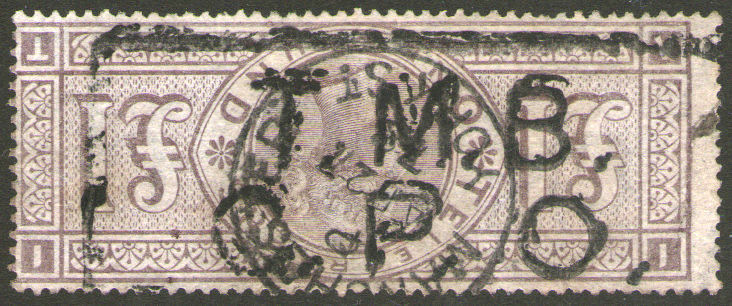
Boxed "T.M.B. / G.P.O." This on a Telegraph stamp, but this cancel is also found on the £1 brown postage stamp and later on the £1 green.
T.M.B is Telegraph Message Branch. There is a similar cancellation with T.A.B. / G.P.O. or T.A.B. / EDINR. for Telegraph Accounts Branch shown below.
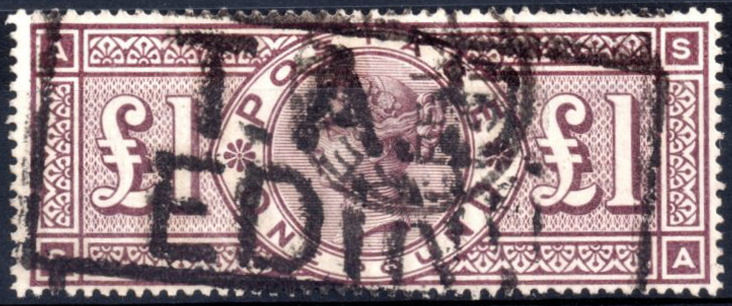
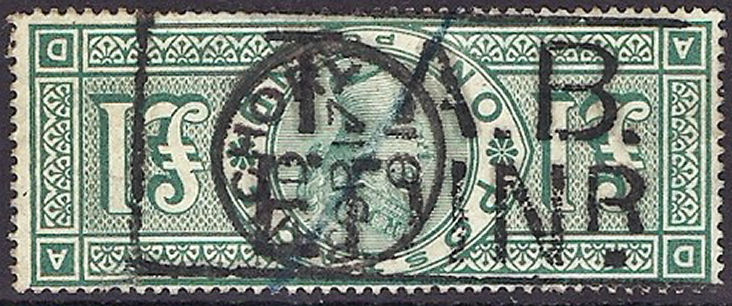
Image courtesy of TONY BROWN STAMPS
This one with boxed T.A.B. / EDINR, together with a circular Greenock T O cancel.
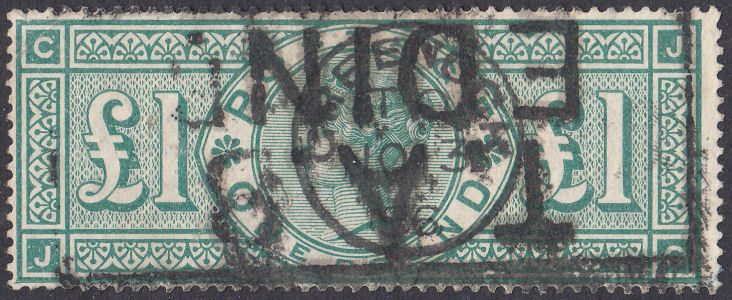
This one with boxed cancel together with a blue Bristol Telegraph Dept cancel.
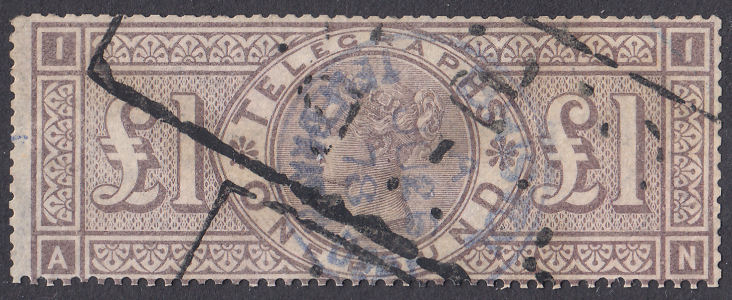
This one is T.A.B. / G.P.O. LONDON in an ellipse, source: Andrew Higson.
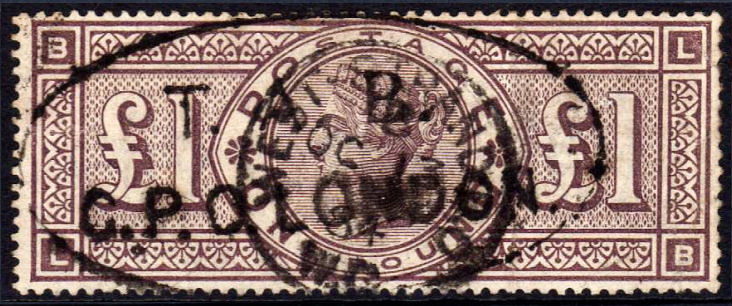
This one, courtesy of Mark Gibson, has a boxed C.H.B. / G.P.O. LONDON in combination with a railway telegraph cancel (679 - Holborn).
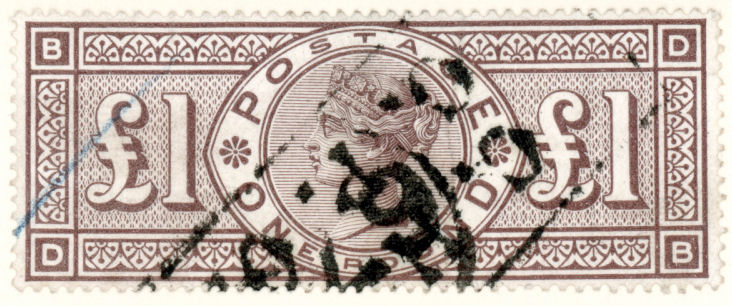
According to Langmead, cancellations like these were used on high values to prevent any possibility of re-use.
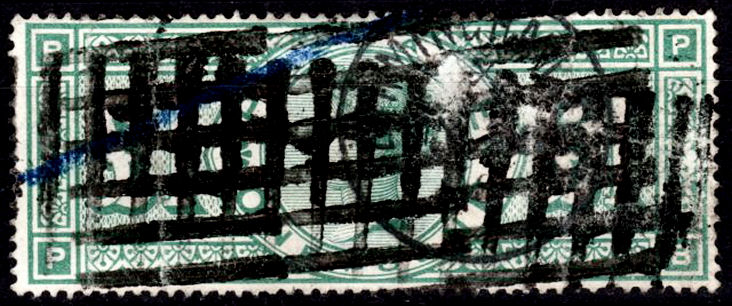
Image courtesy of angellucia1
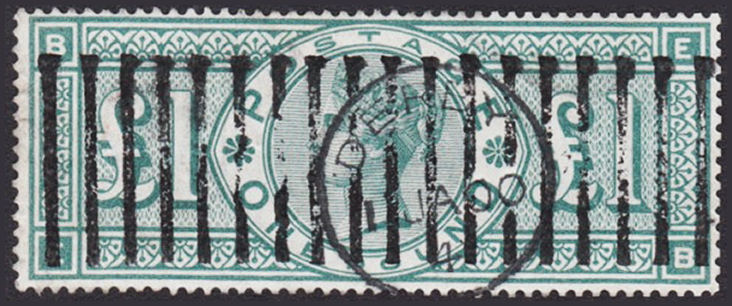
Image courtesy of Andrew G Lajer.
Here is a boxed "T.C.B. / G.P.O" together with a large "1119" Railway Telegraph cancel and crayon marks just to make sure.
Illustration source: Andrew Higson (I have reduced the size).
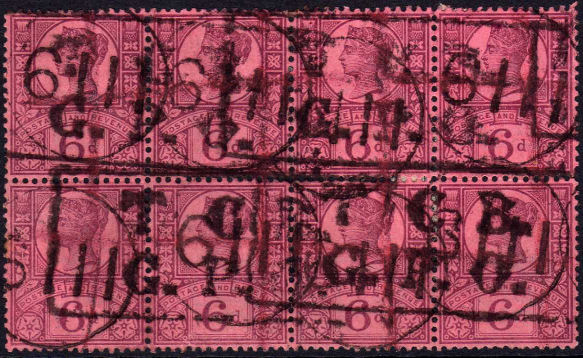
This shows a boxed "C.H.B. / G.P.O" ("Clearing House Branch") on a piece roughly 'liberated' from a Telegraph form.
It is very unusual to see a halfpenny stamp telegraphically used
Illustration source: Andrew Higson (I have reduced the size).
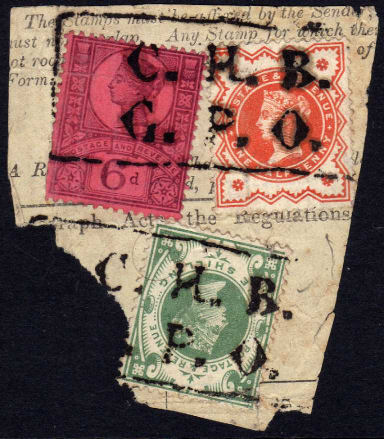
Andrew Higson informs me that Langmead in The London Philatelist of September-October 1982 (p.116) gives this list:
"T.C.B." is not given, but Andrew suggests reasonably that it is likely to be "Telegraph Clearing Branch".
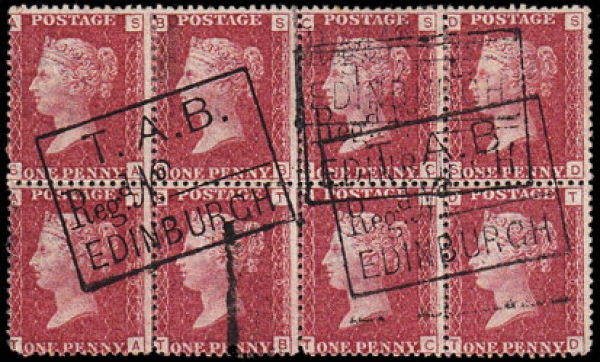
This would appear to be more in the nature of a receipt handstamp for telegraph accounts, and thus fiscal usage. It is quite scarce.
Image courtesy of Andrew G Lajer.
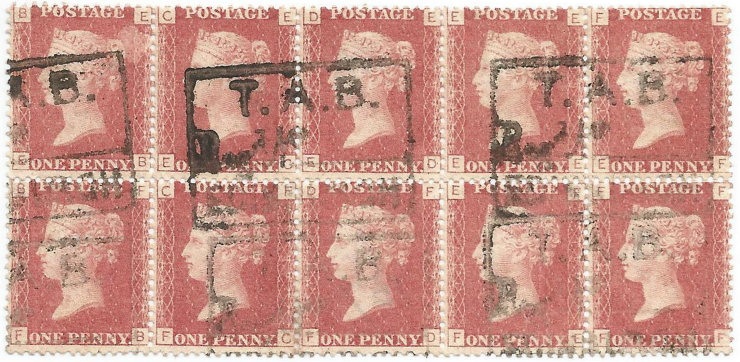
Another block, this of 10 stamps of plate 137. I suspect letters EA and FA are also around somewhere.
Image courtesy of Colin Hanson
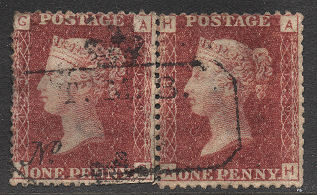
This one courtesy Mike Carter of Shaftesbury Philatelics is similar to the above,
but with T.M.B (Telegraph Message Branch) and an added crown.
There is an interesting new related article on the Perfin Society website.
This is an unusual one,
Ulster Railway Belfast Telegraphs
I am not aware of any other examples of a railway cancel these.
Anyone have other example ?
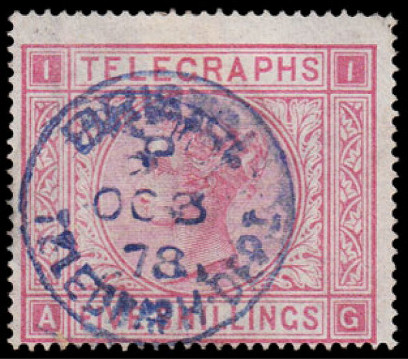
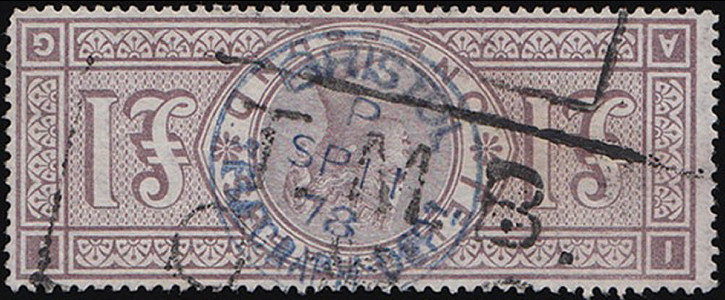
Bristol Telegraph Dept. Two nice blue examples of 1878 courtesy of Andrew G Lajer.
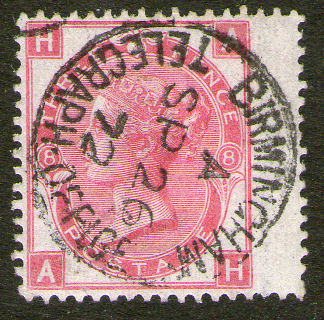
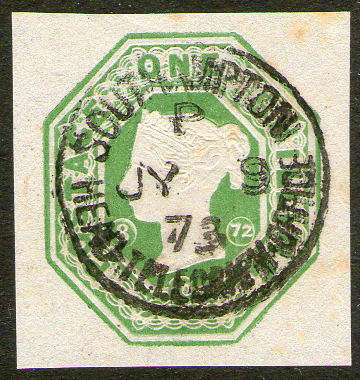
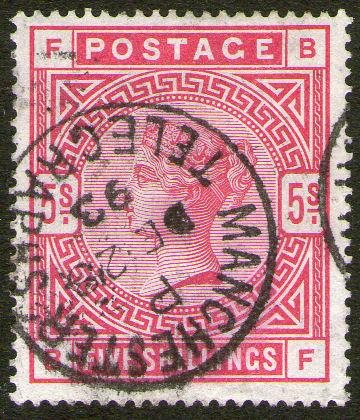
Birmingham, Southampton and Manchester Telegraphs Offices.
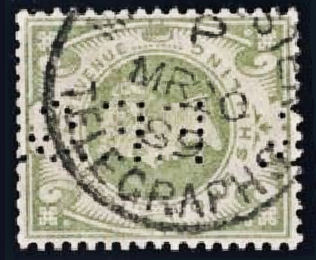
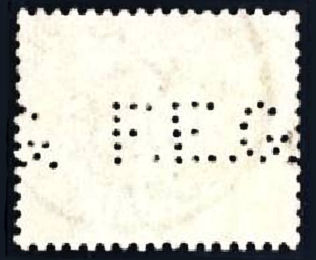
Another Manchester Telegraphs cancel, this on a 1/- with an F.E.G. perfin. This is thought to be F.E. Gaddum of 3 South Street, Albert Square, Manchester.
There is also an unofficial protective underprint of that name listed by SG as Type 25A and may be a similar unlisted one, see this PDF doc.
Perfin Die Reference F 1300.01, images courtesy of Jeff Turnbull.
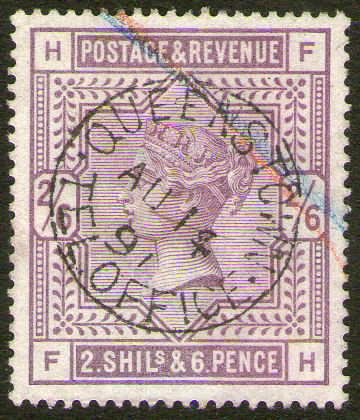
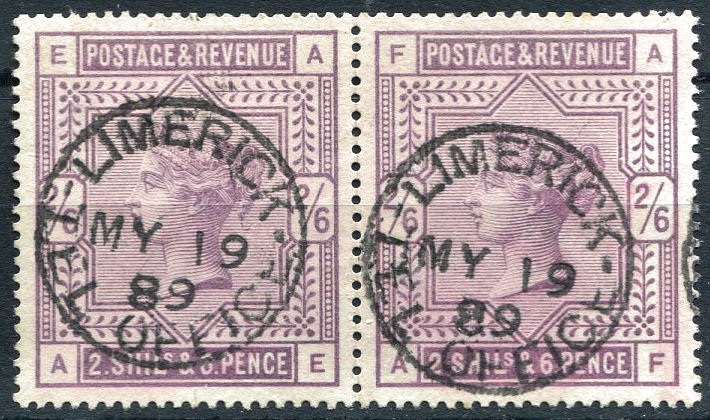
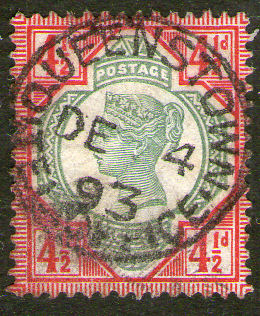
Queenstown "Tel. Office", Limerick Tel. Office courtesy Nicholas Turner at Capital Collectables and Queenstown Tel. Office courtesy BygonesOfBridlington.
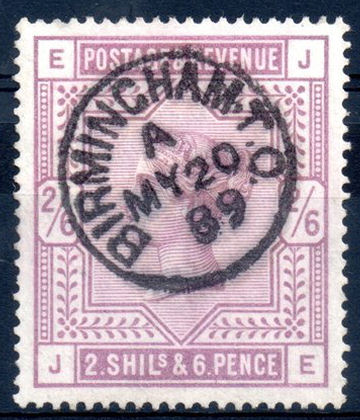 |
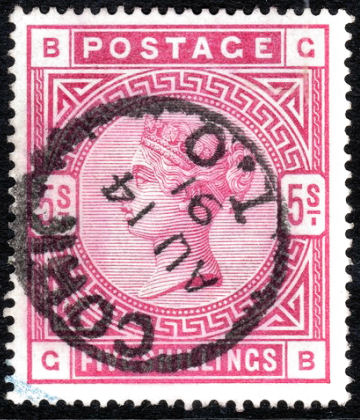 |
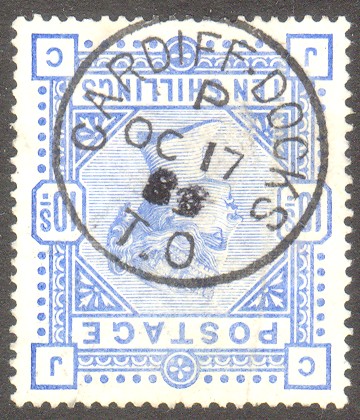 |
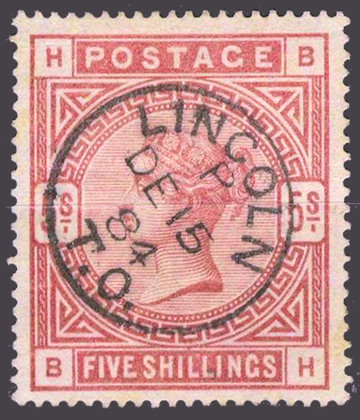 |
| Birmingham "T.O." | Cork "T.O" courtesy of Andrew Oakley | Cardiff Docks "T.O" | Lincoln "T.O." courtesy of Allan Oliver |
Abbreviated to 'Tel. Office' and then a further abbreviation to 'T.O'

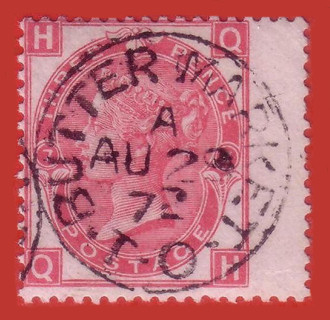
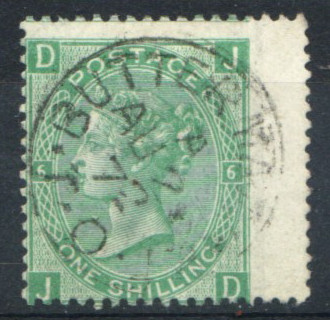
More 'T.O' examples from Birmingham and 'Butter Market', a new commercial centre in Hereford established 1860 in the old Butter Market.
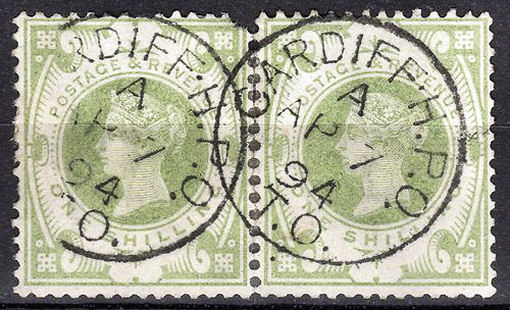 |
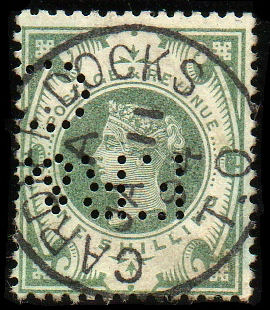 |
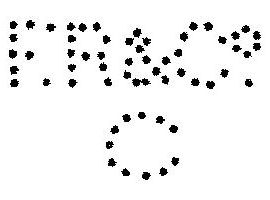 |
| Cardiff H.P.O. T.O. pair. | Cardiff Docks T.O with perfin. | F.R & Co. / C perfin. |
| Courtesy of Michael Bates | Courtesy of Jeff Turnbull. | |
Or just 'T.'
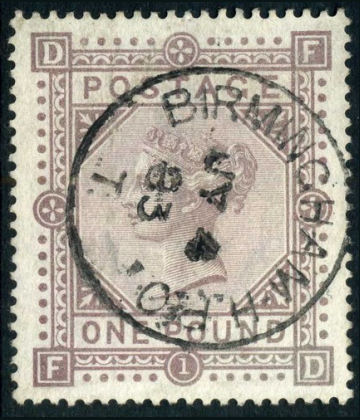 |
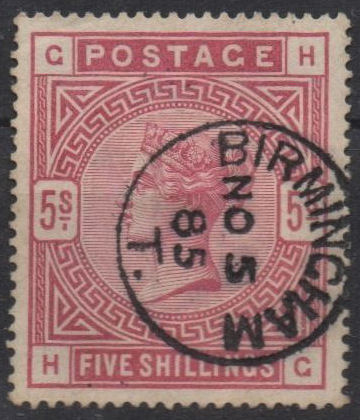 |
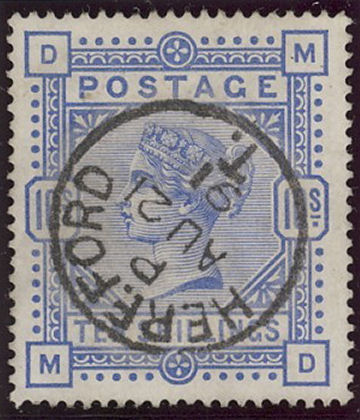 |
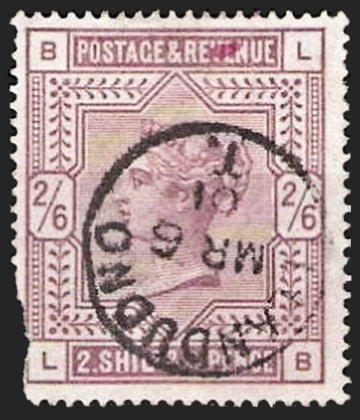
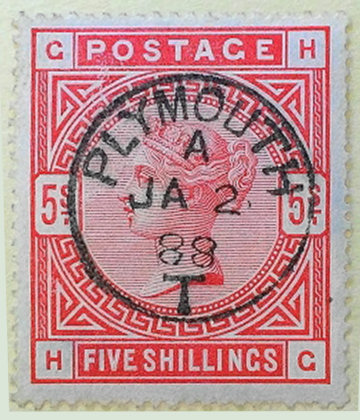 |
| Image courtesy Devlan Kruck. of empirecollectables. | Image courtesy of Ray from wickham-stamps on eBay. | Hereford T. courtesy of johnlam111 on eBay. | Llandudno T. and Plymouth T (without dot) courtesy of Allan Oliver. |
Finally just plain 'T'
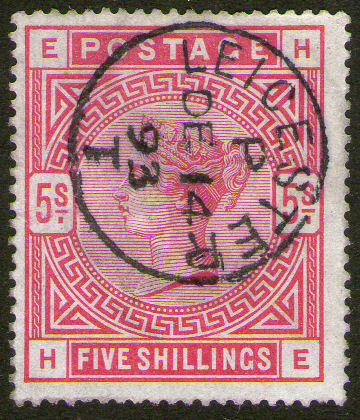 |
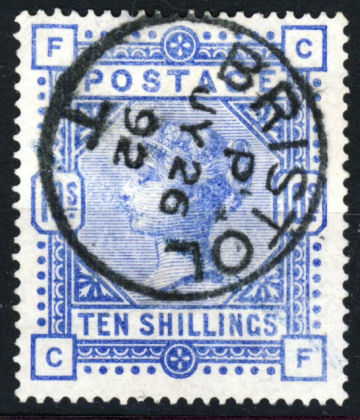 |
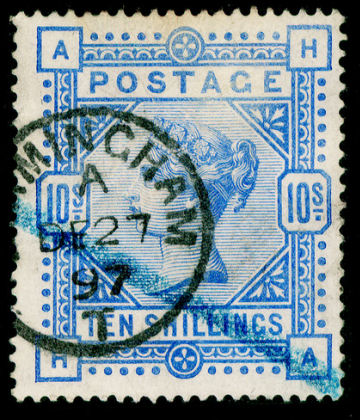 |
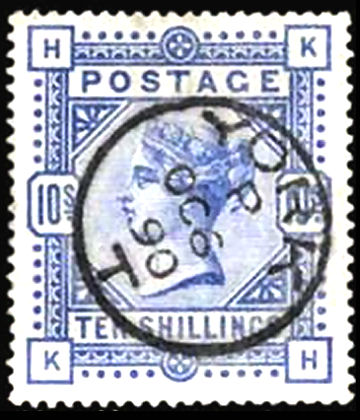 |
| Leicester T - one of mine. | Image courtesy of Roy Dinsdale | Image courtesy Richard Walker of 1st4stamps on eBay. | Image courtesy of Grosvenor Auctions. |
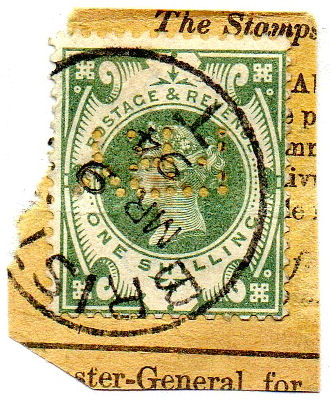 |
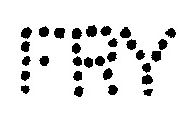 |
| As evidence of these being Telegraphic, here is one on a part Telegraph form with an ' FRY ' perfin. User unknown. But Postmarks of Bute Docks Cardiff, and here Bristol. Images ourtesy of Jeff Turnbull. | |
Or not even a "T"
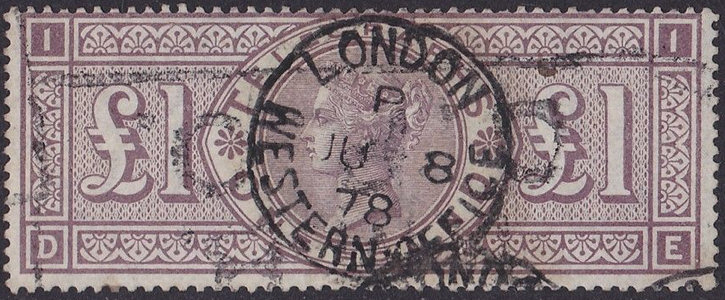
London Western Office, courtesy of Allan Oliver. I'm not exactly sure where that was, but a later, 1887 example
on a 10/- Postal shown on
StampsOfTheWorld mistakes it for London's Western District Office,
which they say opened in 1890 at 19 Old Cavendish St. The location may be the same.
This use on a Telegraph stamp suggests that their 10/- stamp was telegraphically used.
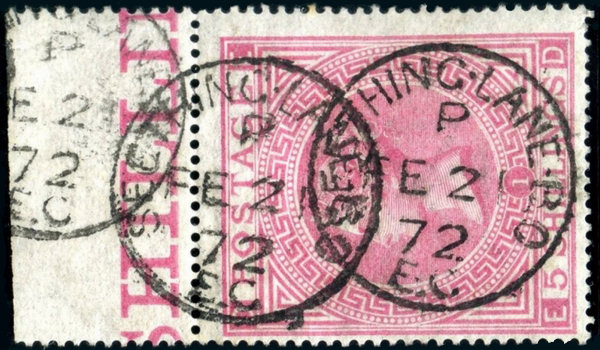
Seething Lane B.O. is another one with nice neat C.D.S. cancels at a time when "killer cancels" were the postal norm.
Note the 1872 date. A lot of used telegrams were "liberated" from that year. Image courtesy of Allan Oliver.
Cancels found on Telegraph stamps, could also have been used telegraphically on postage stamps.
Often the time is left blank.
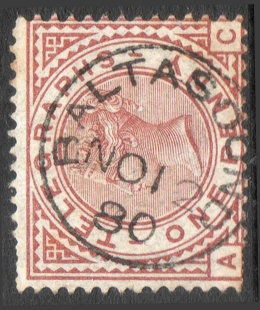 |
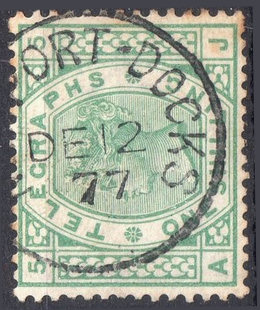 |
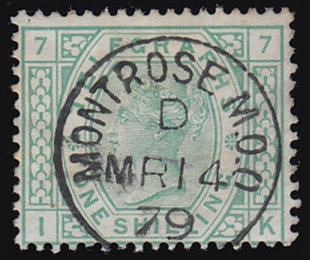 |
| Baltasound, Shetland. | Newport-Docks | Montrose, Scotland Money Order Office |
Images courtesy of Allan Oliver.
Just to complicate things though, Telegraph cancels were not always used only for telegraphs.
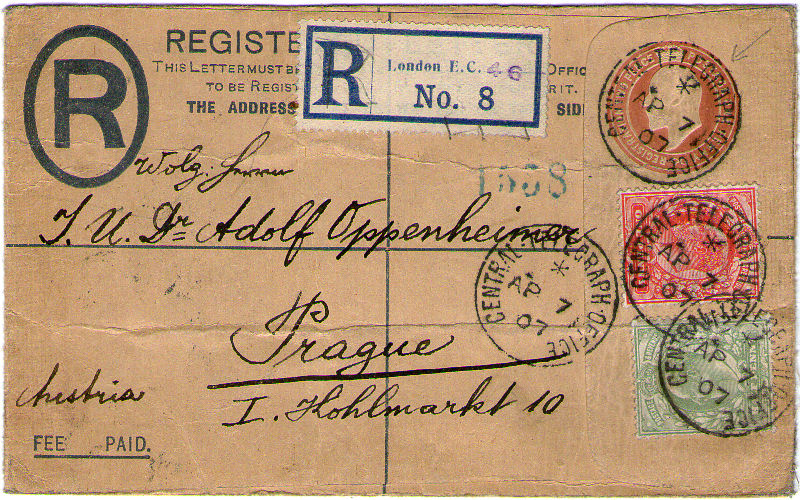
This might explain some telegraph cancels on low/strange value postage stamps.
The examples below (Courtesy of Grosvenor Auctions) has possible lettering 'E C' and 'F C'
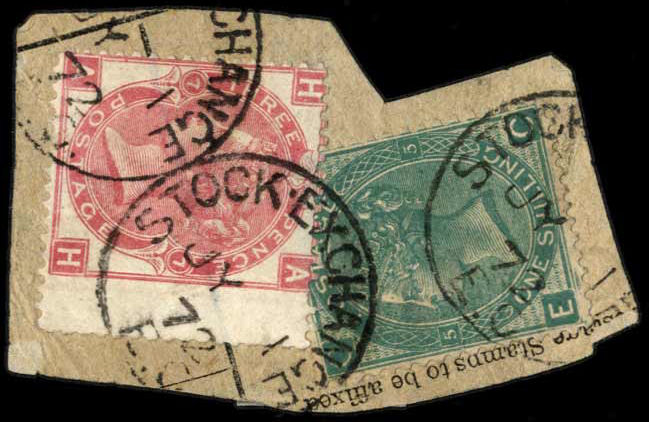
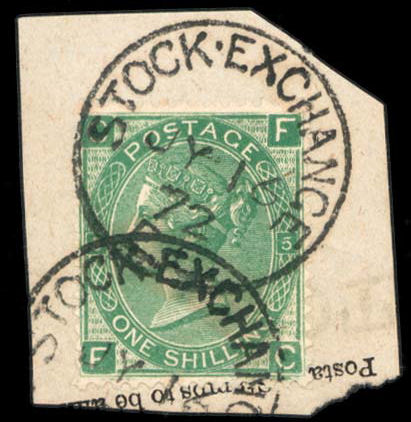
The 1s 'stamps' are preserved on the Stock Exchange forms as they add to the value of the forgery.
The 3d stamp would normally have been removed and sold as postally used with a 'nice cds'.
All 3 examples are dated in July 1872, a good year for CDS's.
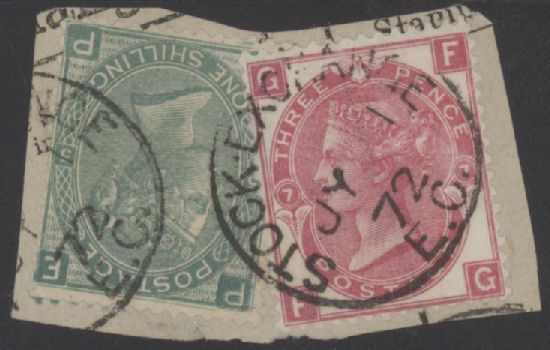 |
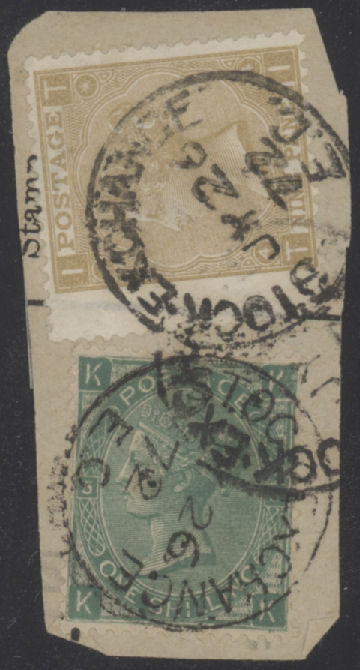 |
| This has impossible lettering 'EP'. |
|
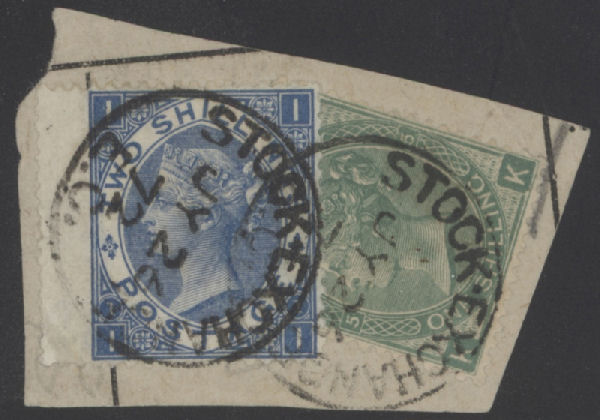 |
|
| With a 2/- as in Melville's book. | Unusually this forgery is not overlapped by the other stamp. |
| These 3 examples (again all July 1872) are courtesy of Michael Driver. | |
The example with the 2s, and perhaps others were in Sale 36 Lot 25 of Schuyler Rumsey Philatelic Auctions.
The Telegraph System was the glue that held the British economy and indeed the Empire together. It was their lifeblood.
It was as indispensable to Victorian business as the computer is now. For that reason it was made available wherever there was a commercial need.
An interesting article can be found at VictorianLondon.org which lists telegraphic facilities,
The list is primarily for London, but also gives a few for the the rest of England.
There can be little doubt that all important cities and docks throughout Britain were suitably equipped.
Note: At the bottom of that page there is a (small) image. Click on it for a list of opening hours for some London Telegraph Offices.
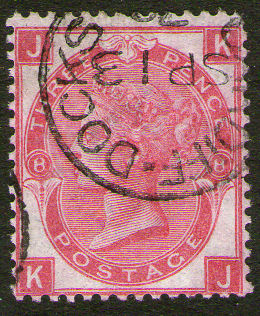 |
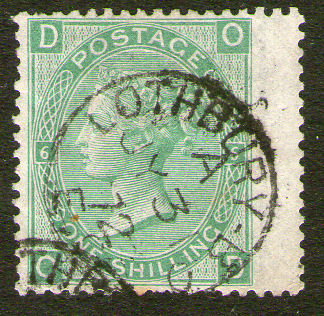 |
| Cardiff Docks | Lothbury (Ex-Electric Telegraph Co. Offices) |
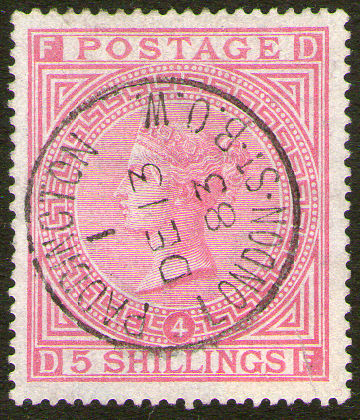 |
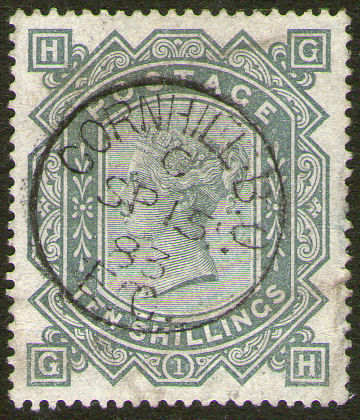 |
| Paddington, London St. | Cornhill (Ex-Electric Telegraph Co. Offices) |
B.O. Cancels (Branch Office) - In busy offices cancels were often used for purposes other than the intended one.
For postal and parcel use, policy was to obliterate the stamps, and this was sometimes done with great gusto.
With telegraph forms, this was not necessary since the stamps along with the forms would remain in the hands of the post office until pulped.
Hence the incentive to 'liberate' telegraphically used stamps, especially the more sought after ones.
For any given example, unless still on piece, it is not possible to say with certainty what the usage was, but for offices known to have telegraphic equipment
it is likely that nicely used examples, particularly from the 1871/2 period, were telegraphic.
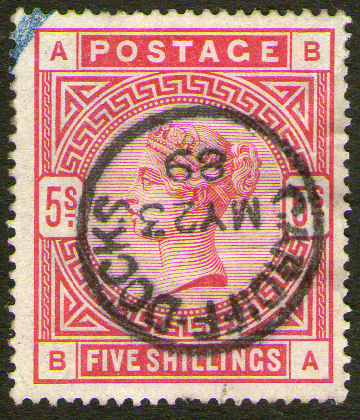 |
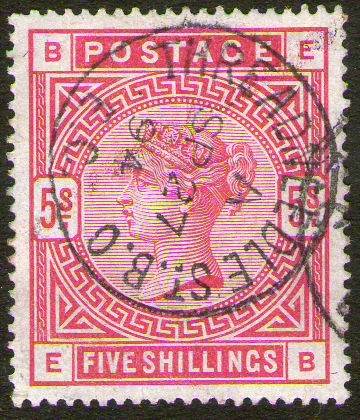 |
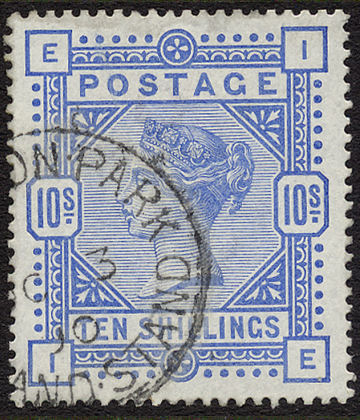 |
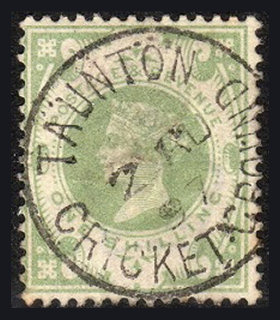 |
| Cardiff Docks | Threadneedle St. (Ex British & Irish and Submarine Tel.) | Scarce Kempton Park Grandstand Courtesy Mike-Holt.com. |
Taunton Cricket Ground Courtesy Allan Oliver. |
Sports grounds had telegraph connections for important events. Not only for journalists, but also for betting (see also Intelligence Department).
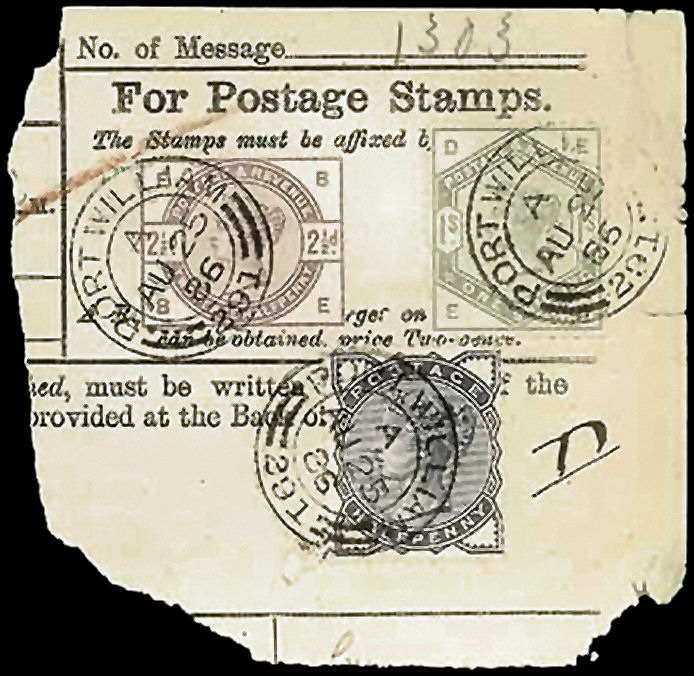
Port William double circle used on Telegraph Form, Courtesy Spink and Son.
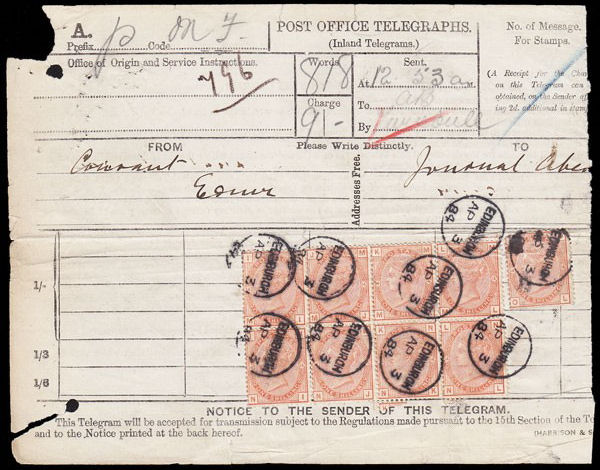
Edinburgh circle used on almost complete Telegraph Form, courtesy of Andrew G Lajer..
It is known that Threadneedle Street Post Office used 'Registered' cancels for Telegraphic use
on values up to the £5 (Ref: www.stampboards.com for evidence and examples).
See also PhilatelicsAnnex.org
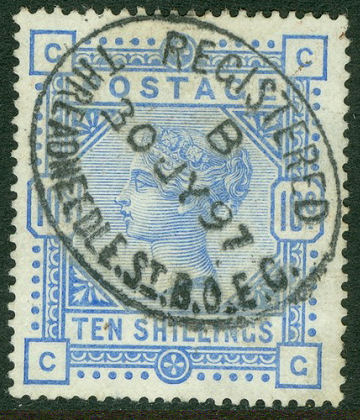
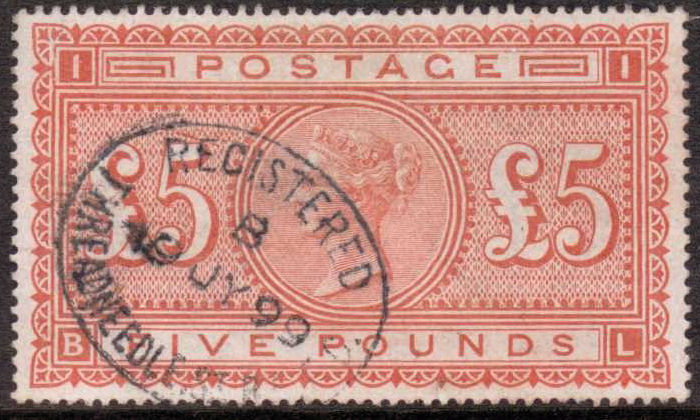
10/- example courtesy of Steve Allen and £5 example courtesy of Andrew Lord.
It has been estimated that apart from a few philatelic items, the £5 was almost never used for postal purposes !
| Courtesy John A. McCulloch, © 2010 ARR. | Courtesy John A. McCulloch, © 2010 ARR. | Courtesy of David Pleiksna. | Courtesy of Ian Pinwill. |
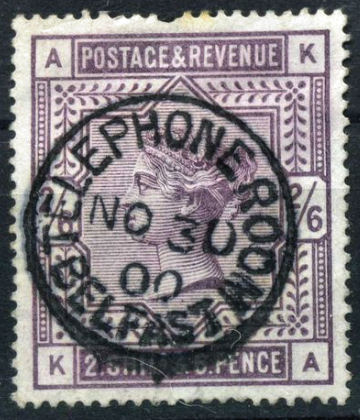 |
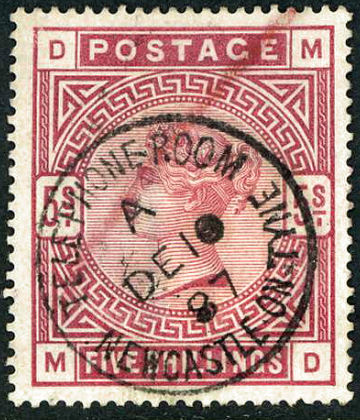 |
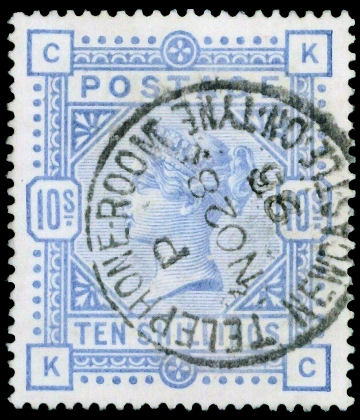 |
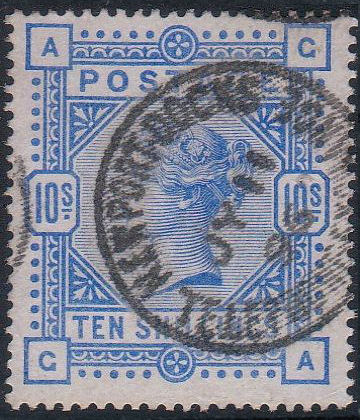 |
| The Telephone Room, Belfast | The Telephone Room, Newcastle-on-Tyne | Newcastle on Tyne Telephone Room | Newport Docks Telephone Exchange |
The last shows the use of a cloth over the cancelling device to retain ink and reduce the frequency of ink-pad use.
A trick used in busy stamping environments.
| One of mine. | Courtesy of Allan Oliver. | Courtesy of Chris Potts. | |
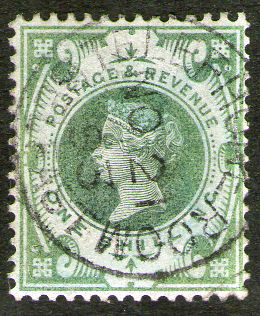 |
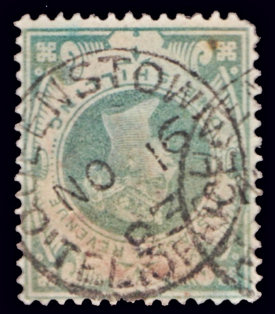 |
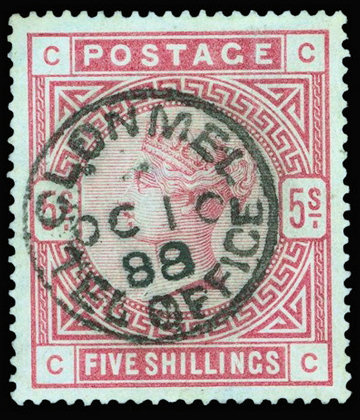 |
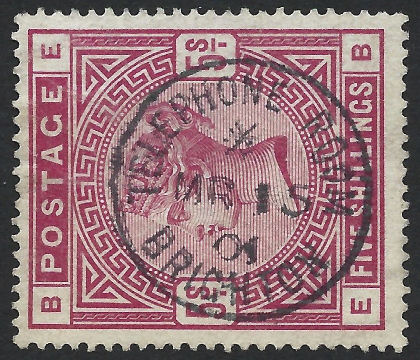 |
| The Telephone Room, Belfast | Tel. Office, Queenstown | Tel. Office, Clonmel | The Telephone Room, Brighton |
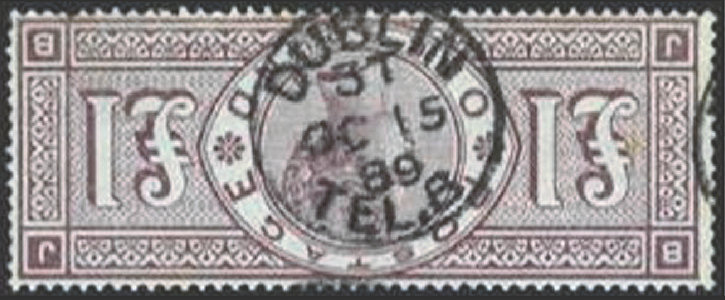
Dublin Tel. Branch - courtesy of Allan Oliver.
P.O would normally be expected to stand for Post Office, but that isn't always the case. Port Offices are highly likely to have Telegraph facilities.
| Courtesy John A. McCulloch, © 2010 ARR. | Courtesy Chris Potts. |
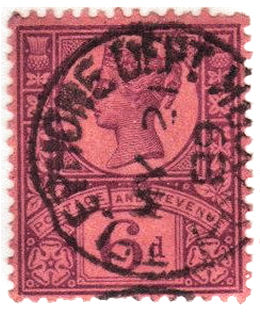 |
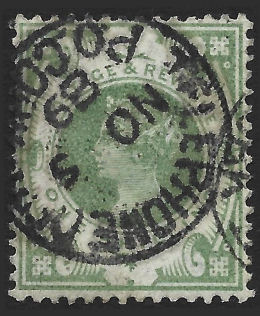 |
| The Telephone Dept. P.O. Cork | The Telephone Dept. P.O. Cork |
The 6d above, I had down originally as "H.O." rather than 'P.O.', which in this case is believed to stand for ‘Port Office’.
My thanks to Chris Potts for correcting me on this with a clearer example.
| Courtesy Chris Potts. | Courtesy Chris Potts. |
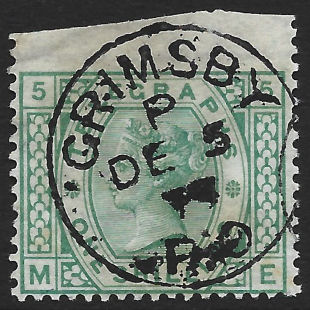 |
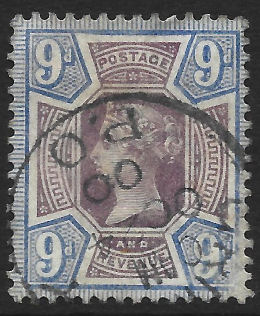 |
| Grimsby P.O on 1s telegraph stamp | Grimsby P.O on postage stamp |
This cancel on a telegraph stamp can be easily accepted as a telegraph cancel.
On a postage stamp though, ‘Port Office’ would not be the first assumption of the P.O meaning !
Located at 30 Mincing Lane, they provided general trade sales for empire/colonial and foreign goods e.g. ivory, leather, cocoa, cotton, feathers, and sugar.
(Information provided by Ian Pinwill who also observes that the cancel on Telegraph stamps is mostly on the 4d.)
The London District Telegraph Company had a branch there by 1861.
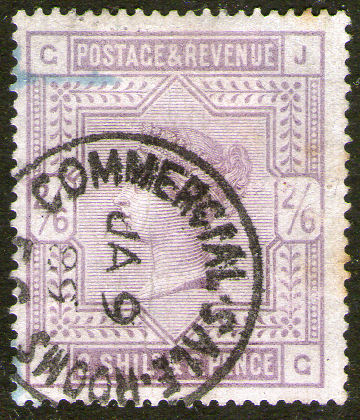 |
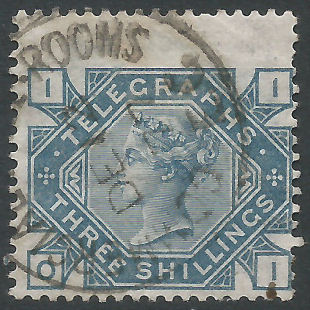 |
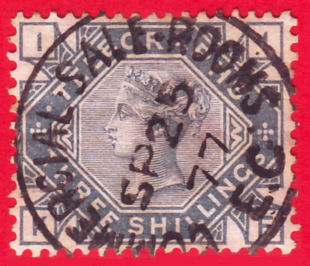 |
| Later often found on high value postage stamps. |
Used on a 3s Telegraph stamp with wing courtesy of Chris Potts. |
Used on a 3s Telegraph stamp courtesy of eBay seller "reallyhelpful" |
See also the Intelligence Department.
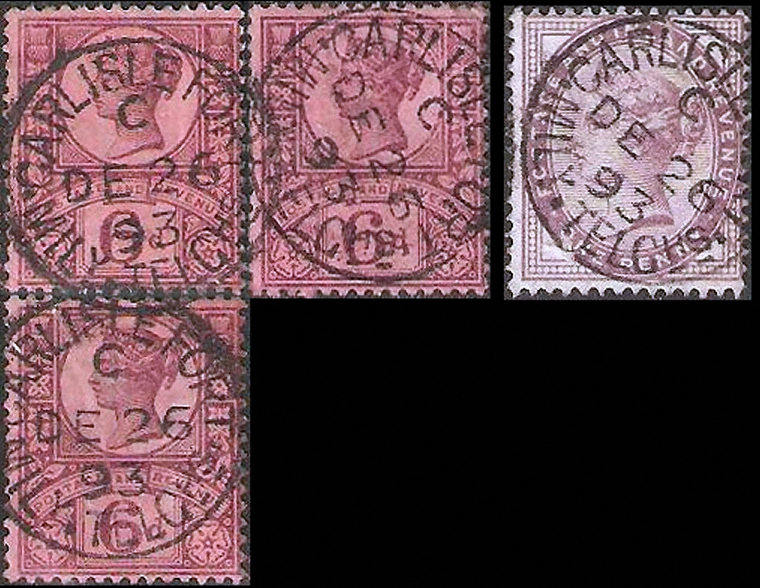
A reconstruction by Ian Pinwill of four stamps (courtesy of Steve Amies).
Andrew Higson who has an example of this datestamp dated 14th January 1887, tells me that Fort Carlisle is located
on a promontory over the entrance of Cork Harbour, Ireland, which puts it close to Roches Point (see further down).
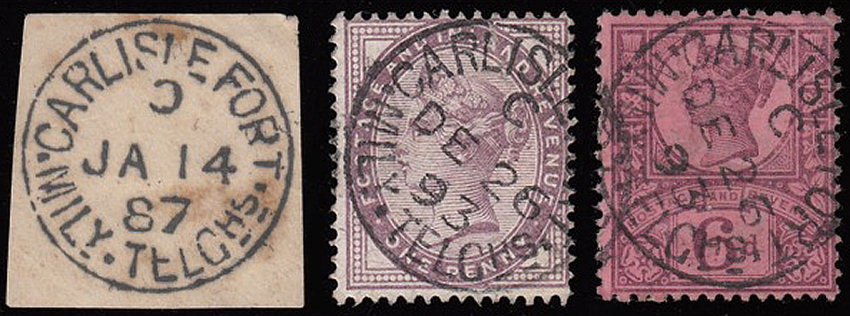
This current offering (December 2018) from Andrew J. Lajer has two of the same stamps from above and an older but similar cancel on piece.
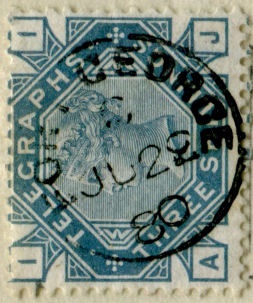
Fort George (guarding Inverness) courtesy of Ian Pinwill.
Large influential 'Houses' sometimes had telegraph stations.
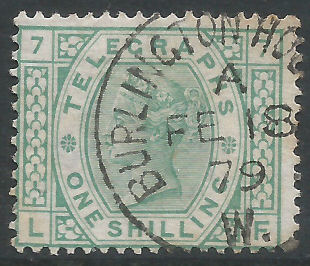 |
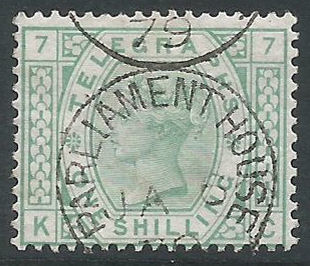 |
| Burlington House, W1 on a 1/- plate 7 Telegraph stamp. courtesy of Chris Potts. |
Parliament House, Edinburgh on a 1/- plate 7 Telegraph. courtesy of Chris Potts. |
Westminster Palace Hotel had an office of the London District Telegraph Company as early as 1861.
There were also branches at some Coffee Houses (Baltic at Threadneedle Street and the Jerusalem near Cornhill).
By 1866, four more hotels had been added (Royal Hotel at Blackfriars, Bridge house hotel at London Bridge, Tavistock Hotel at Covent Garden
and the Grosvenor Hotel at Pimlico), in addition to which "All stations of the Metropolitan Railway" had been added.
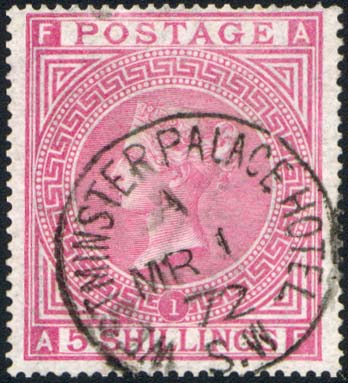
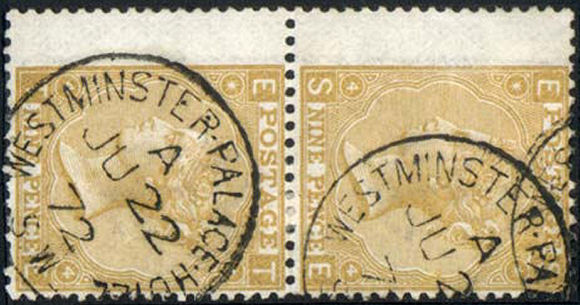
These two items are courtesy of Grosvenor Auctions.
The vendor of the 9d pair included a 2s with the same cancel but did not consider it worth an image!
Markets often needed telegraph stations.
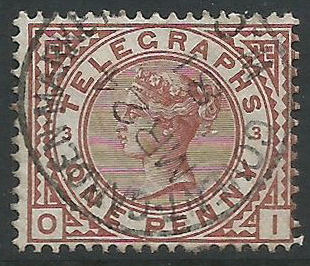 |
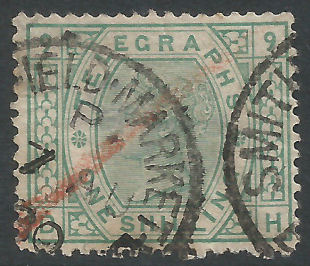 |
 |
| Covent Garden Market on a 1d plate 3 Telegraph stamp. courtesy of Chris Potts. |
Smithfield Market on a 1/- plate 9 Telegraph stamp. courtesy of Chris Potts. |
Butter Market, Hereford on a 1/- plate 6 postage stamp. |
These come under the broader topic of the Intelligence Department.
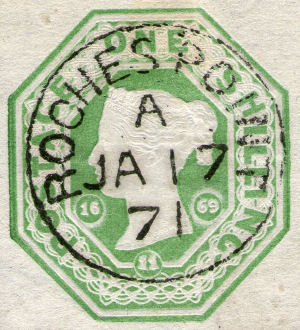
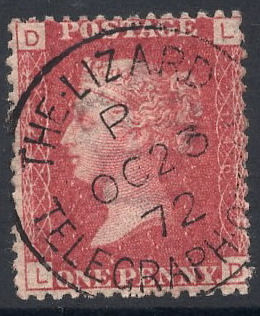
Roches Point is not a good place for a post office being quite far from sizeable habitation, however it had been an important
Telegraph Station of The Electric Telegraph Company due to its' location at the entrance to Cork Harbour.
The Lizard in Cornwall at the Southernmost tip of Britain was another excellent location for a telegraph office (courtesy of Ian Pinwill).
It should be noted that there were also a number of Lloyd's Stations that appear to have connected to the railway network and were supplied with railway telegraph cancels.
Telegraph forms using these embossed stamps were available 5th February 1870, the date plugs on this indicate
it was printed 3 months before the Post Office took over operations and was not used until nearly a year after.
Roches Point is now the site of a lighthouse and weather observing station. The Lizard also has a lighthouse.
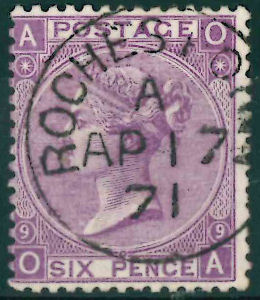
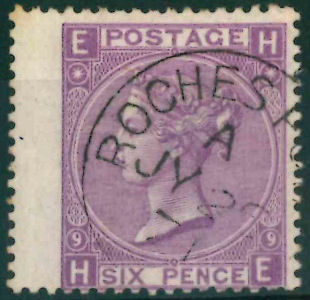
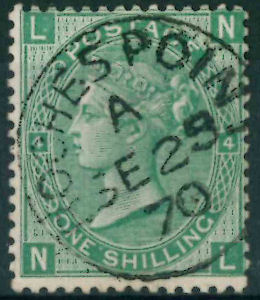
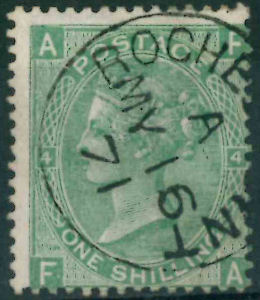
Padraig O Shea of Raven Stamps tells me that he recently purchased a small lot of Roches Point cds cancels, seven one shilling Green Plate 4 and four 6d Violet Plate 9.
Shown above are the earliest and latest of the two denominations.
Such usage was not confined to the Victorian period but carried over into the Edwardian period also, but not always this obvious.
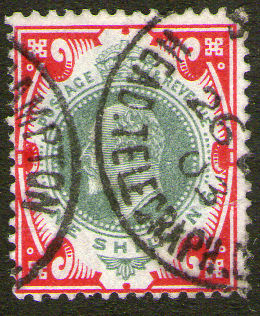
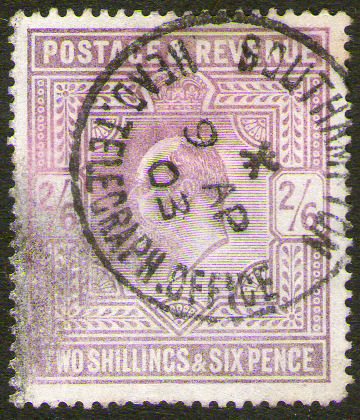
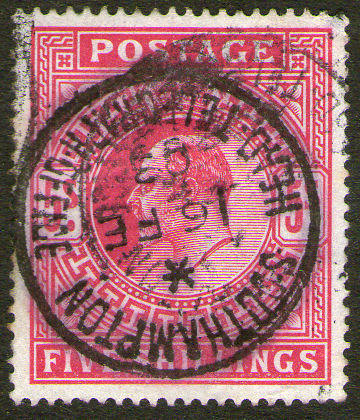
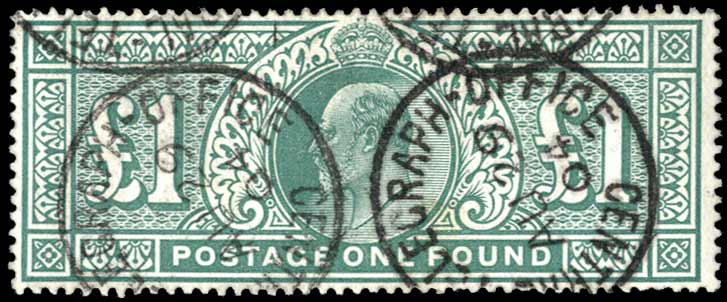
The £1 courtesy of Grosvenor Auctions.
This part Edwardian Telegraph Form is interesting for several reasons.
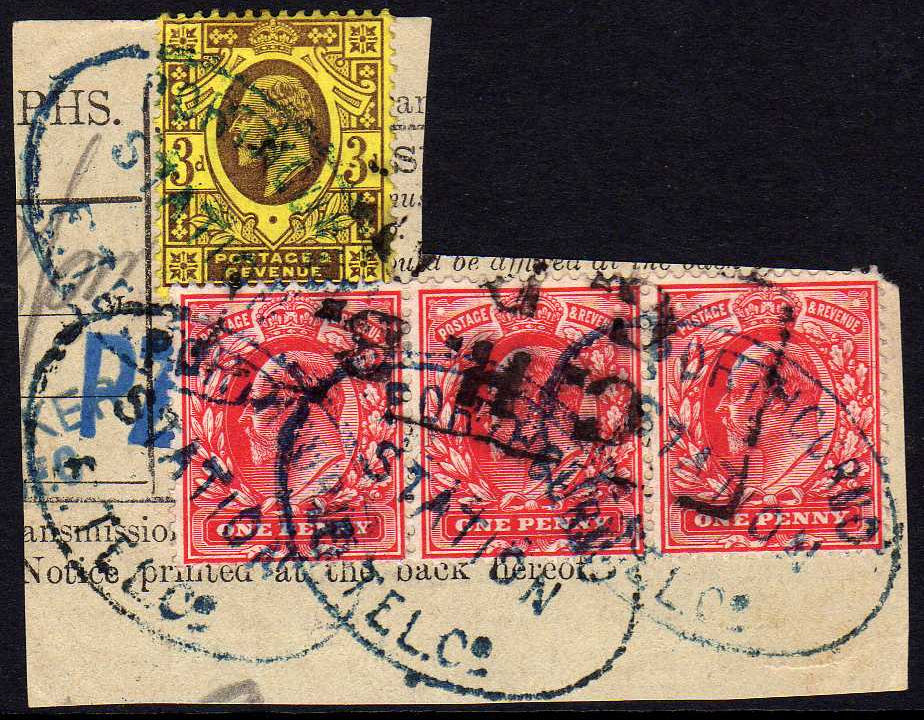
Firstly the boxed "C.H.B. / G.P.O." is often seen on high value Victorian postage stamps, but clearly may indicate telegraphic usage.
In addition, The oval Station cancels normally have the name of the Railway Company at the bottom. Here it has the Station name Porthcurno and "E.TEL.Co."
This is the Eastern Telegraph Company that in 1902 erected a Wireless Telegraph mast at nearby Pedn-men-an-Mere.
Porthcurno near Land's End, Cornwall was the terminus for submarine telegraph cables from 1870 to 1970, connecting with the Americas and India via Europe.
This Telegraph Station was once the largest cable station in the world, and also had a Telegraph training school.
Illustration source: Andrew Higson.
Here is another from Porthcurnow (note alternative spelling) dated Christmas day 1904.
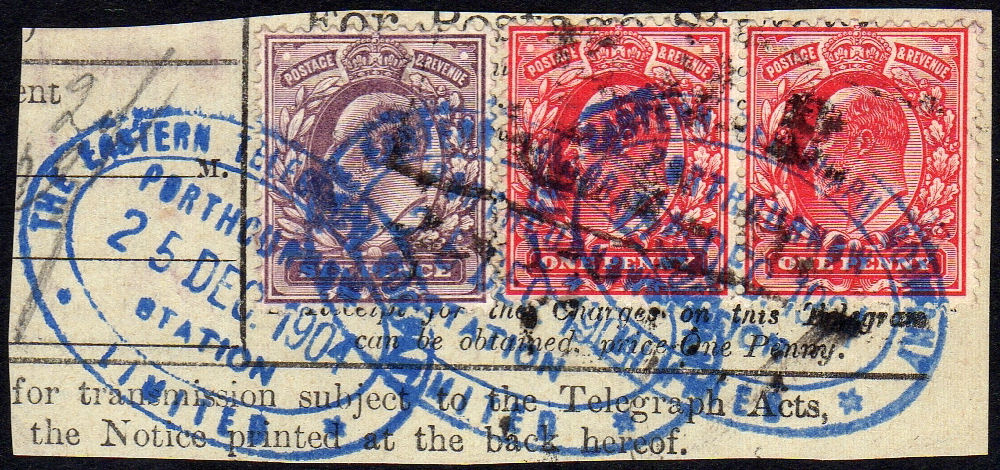
This is also courtesy of Andrew Higson.
Interestingly, The Post Office issued the number 1097 in a 16mm diameter circle to Porthcurnow on 30/6/1870
and in a 22mm circle on 22/8/1872, though there appears to have been no such railway station! A stamp of 1881 is known with the number on however.
Anyone know of a railway station there?
Eastern Telegraph Company Seal.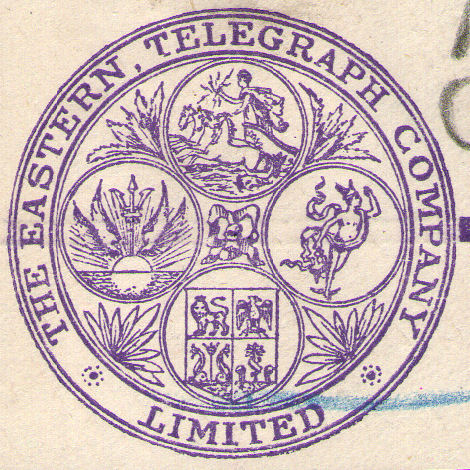
There were still problems with the theft of used telegraph stamps for the philatelic market,
particularly from the private companies that still operated services to other countries.
After a number of trials in 1915 and 1918, clipping devices were sent out in 1919 to 30 telegraph offices (26 office in England and Scotland, 4in Ireland)
with instructions to clip stamps of 2/6d and higher values before affixing to telegraph forms. These instructions were often not followed correctly,
such clipped stamps are found on stamps used for parcel post and often stamps used on telegraph forms escaped clipping.
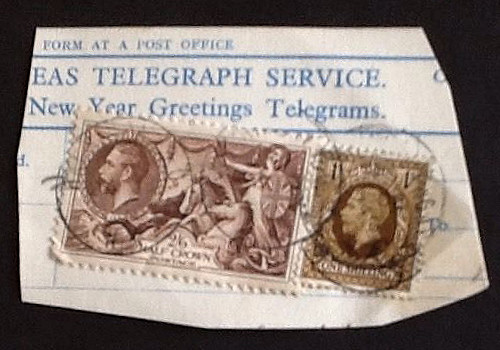
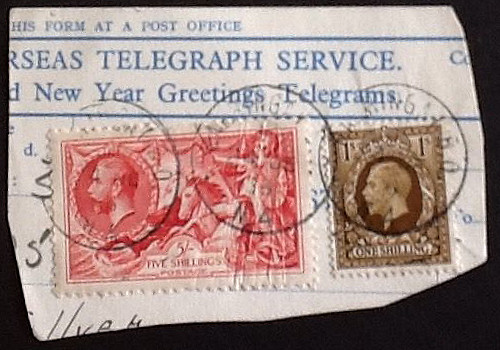
These 1934 seahorses courtesy of Christine on eBay, show no sign of being punched or clipped.
Nor does this
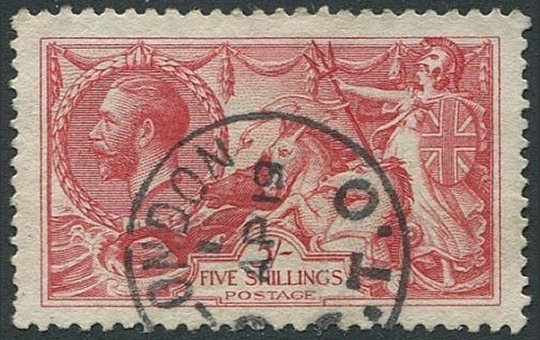
London C.T.O. 1919 courtesy of Allan Oliver.
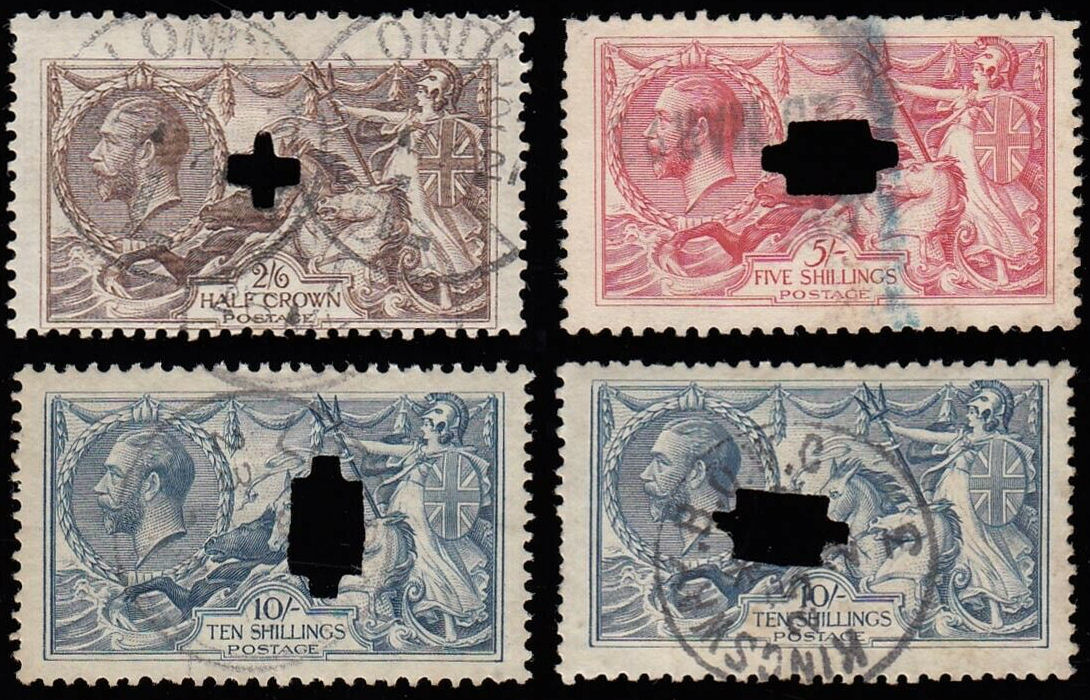
These do though (SG413a/417). Image courtesy of Andrew G Lajer.
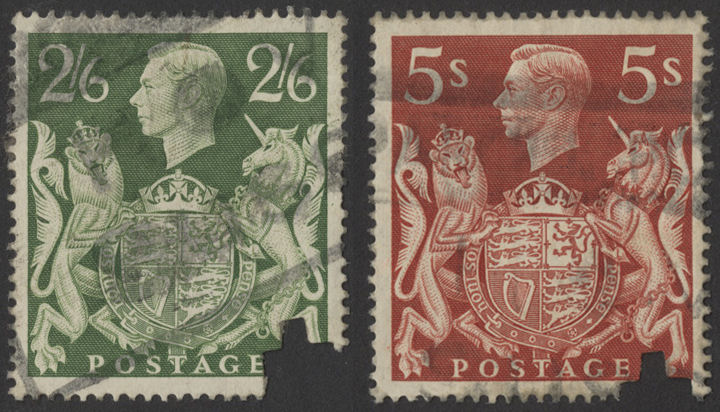
Richard Monteiro supplied these images and brought to my attention the article "Surreptitious Removal" by Les Wilkinson
that explains the reasons, trials and end results in great depths.
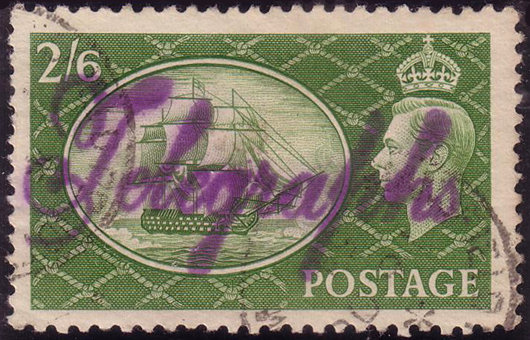
A "Telegraphs" cancel on a 1951 2/6d courtesy of Rolf Lamprecht.
A number of 1964 forms have recently come on the market.

This has the 2s6d and 5s stamps clipped similar to the above.

The 10s stamp on this though has had the centre torn out. This seems quite common. I have another example from Bermondsey dated the day before with an intact 5s stamp.
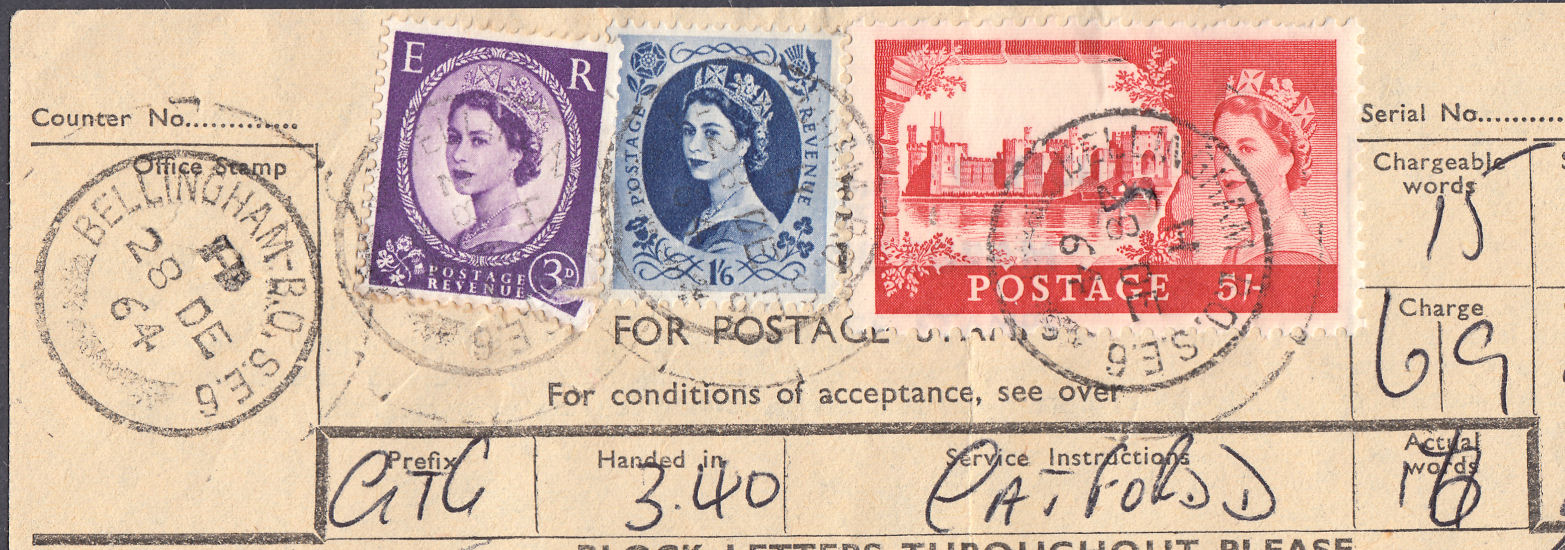
Though not obvious, the 5s stamp has been spiked after fixing to the form.
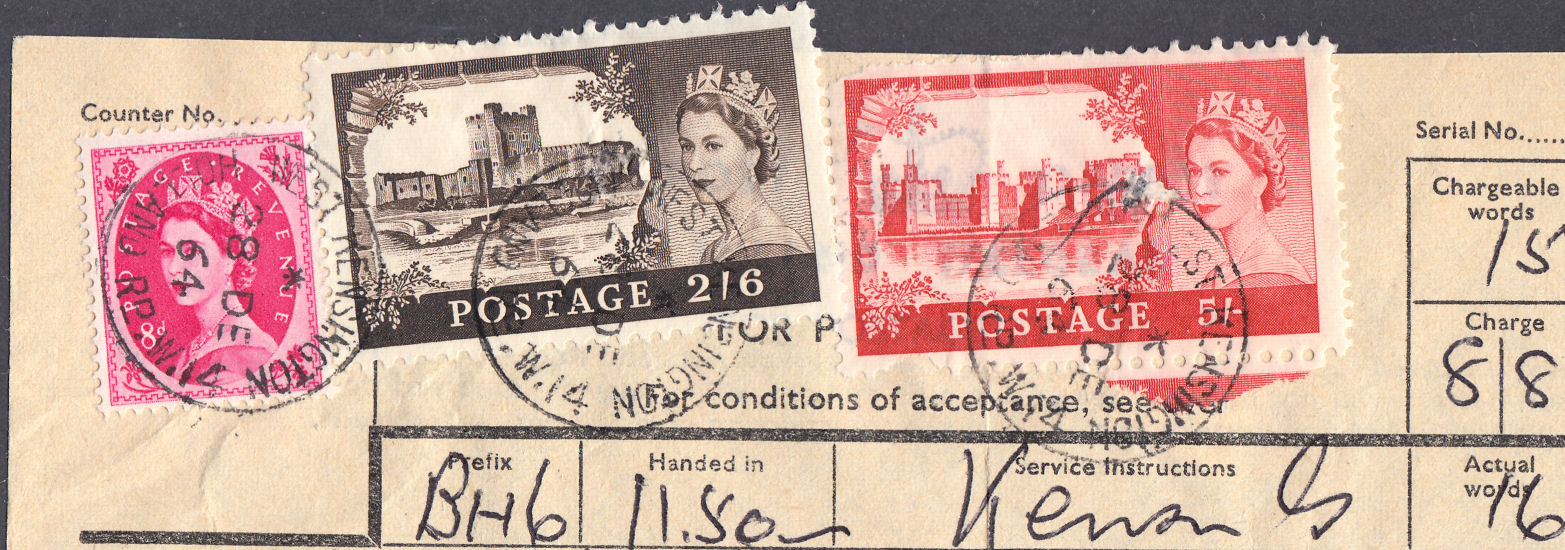
On this, the 2s6d and 5s stamp have both been spiked through the form. There is a 6d on the back, pushed away when the 5s was spiked.
An article by Sam Lawrence, FRPSL in the GB Journal of January/February 2000 (Vol. 38 No. 1) showed many more examples of
Elizabethan high values, low values and commemoratives.
I was recently shown these by Rolf Lamprecht. The images in this section are from him.
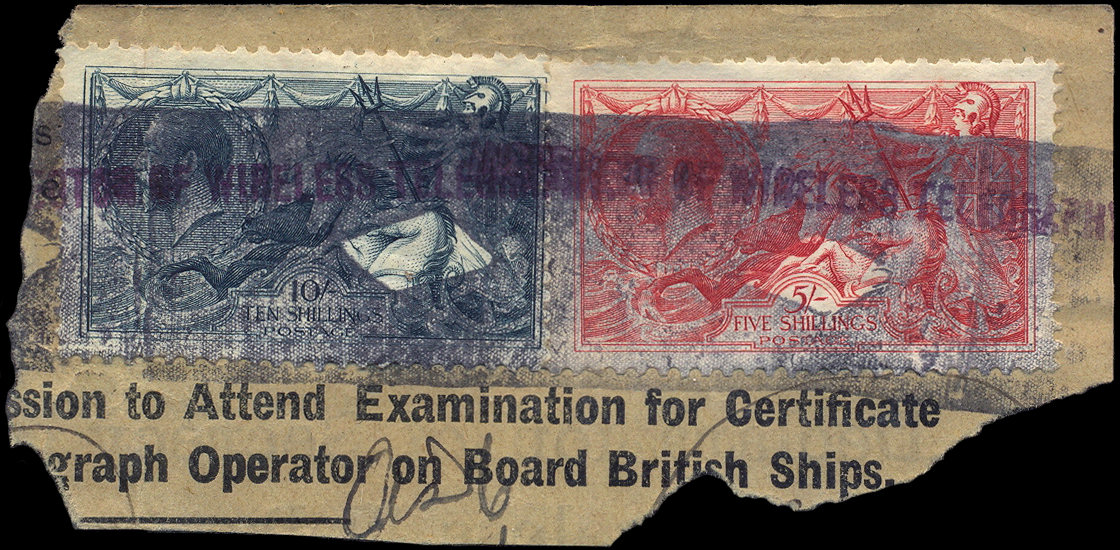
Not easy to see, but these are stamped with 'INSPECTOR OF WIRELESS TELEGRAPHS'. The form appears to be an
application for permission to attend an examination for certification to be a wireless telegraph operator on British ships.
The stamps show the guide dot of the Bradbury Wilkinson printing of 1918.
The inquiry subsequent to the sinking of the Titanic sparked a number of international conferences designed to improve safety at sea by setting international standards.
Among the changes, the Merchant Shipping (Wireless Telegraphy) Act of 1919, contained a number of changes.
The Merchant Shipping (Safety and Load Line Conventions) Act of 1932 (part 1, section 6-11 and 13) required all sea-going passenger steamers,
and other ships over 1600 tons, not exempt under the 1919 act, to
include a survey by a wireless telegraphy surveyor.
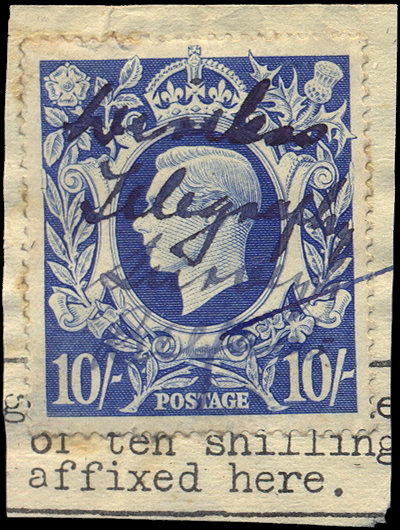
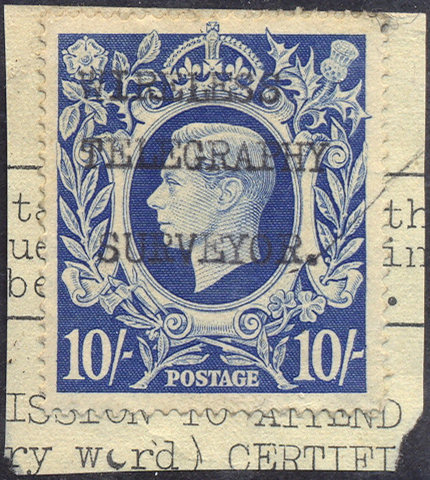
Both have the words 'WIRELESS TELEGRAPHY SURVEYOR.', though the first is in manuscript
and has additionally what could be a signature at the bottom.
These two appear to be similar to the above, but a bit to the right, showing cachets.
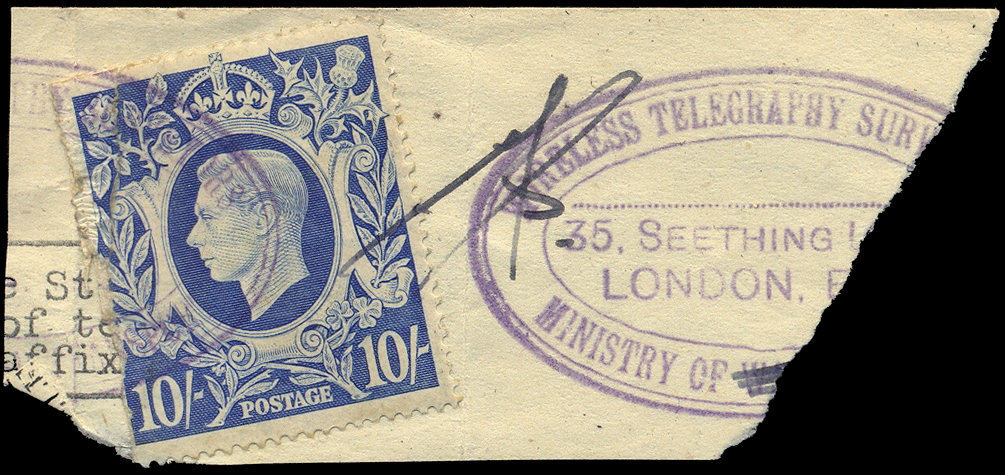
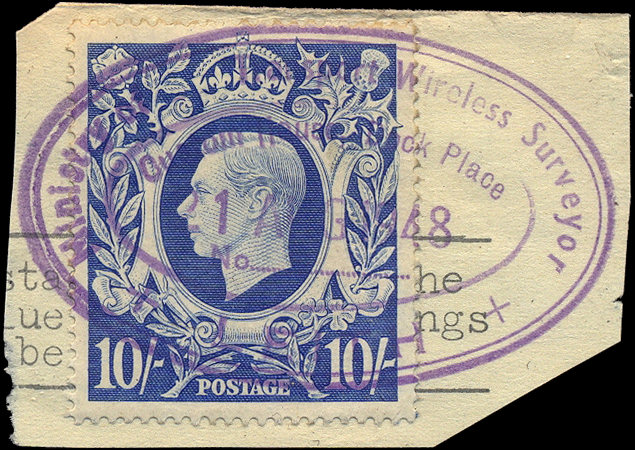
The first is inscribed "Wireless Telegraphy Surveyor. / 35 Seething Lane / London E(C3)", this was called Walsingham House which was built in 1929,
following the establishment of the Port of London Authority.
The other is inscribed "Ministry of Transport Wireless Surveyor / Custom House Dock Place / 21 AUG 1948 / No... / LEITH".
This is to the north of Edinburgh, Scotland.
This piece below, dated 12 February 1943, appears to be on the other side of these forms.
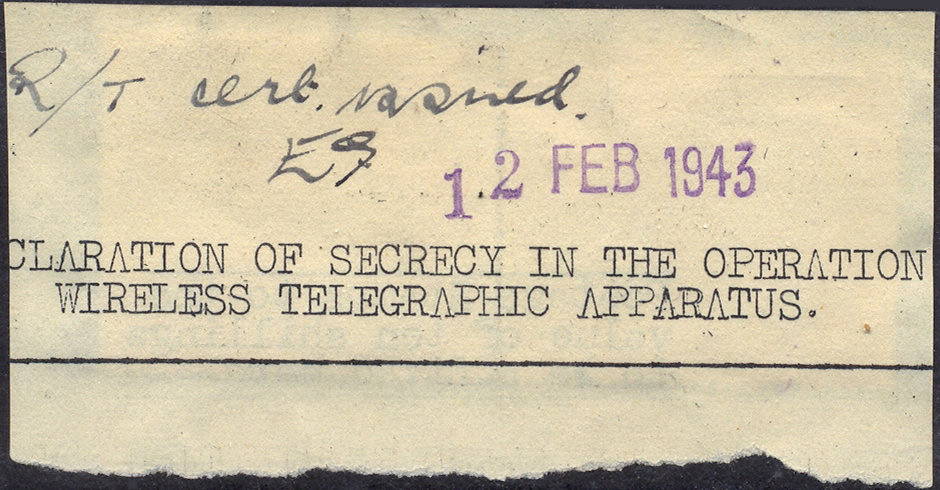
Enhancement shows that the other side has two stamps with wording "value of ten shillings", as on examples shown above.
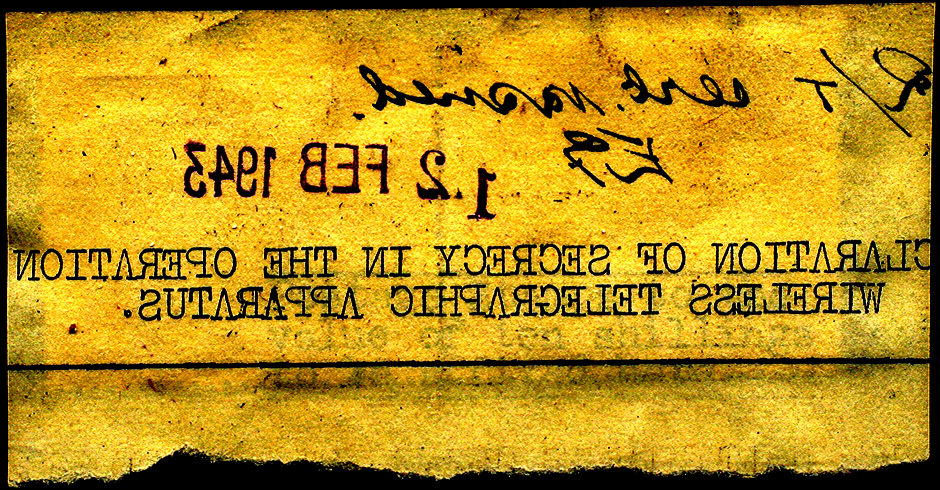
For those interested, there is a map of transmitting stations in Britain in a PDF file at Modern-Wireless April 1923 in an article on page 163.
There is also a lot of useful background information on Radio Telegraph of the time.
Last updated 22nd. June 2023
©Copyright Steve Panting 2012/13/14/15/16/17/18/19/20/21/22/23 except where stated.
Permission is hereby granted to copy material for which the copyright is owned by myself, on condition that any data is not altered and this website is given credit.